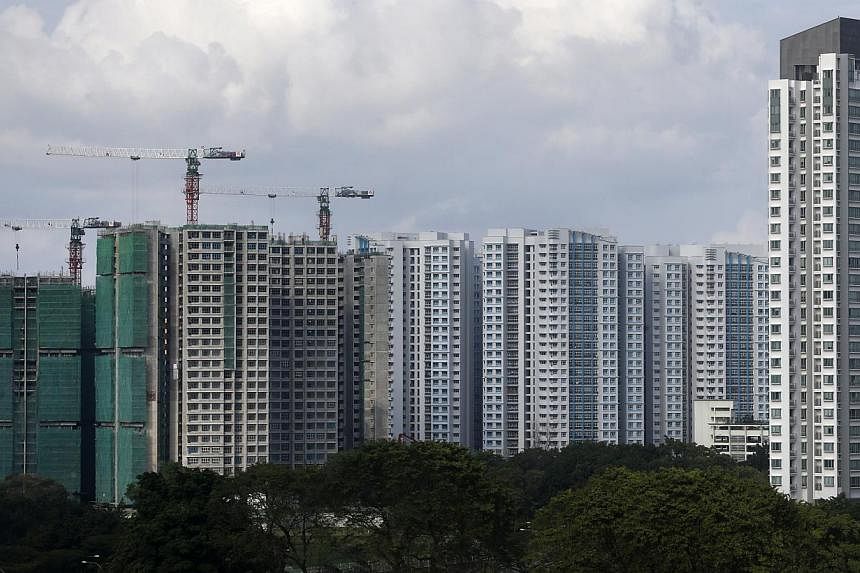There are growing calls from almost every quarter of the property market for the Government to remove some of its measures introduced since 2009 to cool the market.
Developers fret over unsold units while nervy buyers are cautious about catching a falling knife. Property agents are leaving the industry as transactions dry up, while home owners dread the prospect of tumbling property values.
To be sure, the fall in prices is not dramatic: for the whole of last year, private home prices eased 4 per cent and public housing prices fell 6 per cent.
The fall isn't even in the double digits. And as any number of government leaders have noted, prices are still up about 60 per cent compared to mid-2009. As Deputy Prime Minister Tharman Shanmugaratnam reiterated in October, there is still "some distance to go in achieving a meaningful correction, after the sharp run-up in prices in recent years".
But the time has come to at least reduce the pain.
The market is already falling gently. The slide could become hard to arrest, given the overhang of new and soon-to-be-completed private residential units. It's time for the Government to moderate the measures.
Just what would work? Mr Michael Lim, director of research at UBS, said a cut in additional buyer's stamp duty (ABSD) for Singaporeans buying their second homes would be viewed favourably by citizens. He suggested a cut of 1 to 2 percentage points.
Buyers of private residential properties now pay stamp duty of about 3 per cent for all home purchases. Singaporeans pay an additional 7 per cent for their second properties; and an additional 10 per cent for third and subsequent properties. Foreigners pay an additional 15 per cent stamp duty on all purchases.
Another set of cooling measures impose loan limits on buyers, subjecting them to lower loan-to-value (LTV) ratios.
A total debt servicing ratio (TDSR), introduced in June 2013, requires borrowers to keep all debts within 60 per cent of their gross monthly income. Not surprisingly, the slew of measures has indeed cooled the market.
Developers are dangling discounts for buyers, with Ms Yvonne Voon, an analyst at Credit Suisse, pointing out that "prime properties are seeing a sharper correction".
The 158-unit freehold development, The Vermont on Cairnhill, is a clear example. It sold out all remaining 37 units at a median price of $2,113 per sq ft - down from the previous median of $2,313 psf in July last year, which works out to a 9 per cent drop.
Mass-market homes, propped up by demand from Housing Board upgraders, have fared better. But even this previously resilient market could be losing its shine, as a record completion of public homes could "pose risks to prices" and siphon demand from mass-market condominiums, said Ms Voon.
In fact, the decline indicates that the market has changed fundamentally.
An era of cheap debt, brought on by quantitative easing after the global financial crisis, sparked exuberant investing and accelerated housing completions.
As a result, 21,359 more condo units will flood the market this year, with another 36,000 in the pipeline over the next two years.
The rising supply of homes comes at a time when the pool of tenants is declining with curbs on foreign labour growth. Property mania is thus making way for a new normal of rising vacancy rates and falling rental values.
Last year, rents fell 3 per cent - a reversal of four successive years of rising rents. Vacancy rates of private residences rose to 7.8 per cent as at Dec 31 - the highest since the fourth quarter of 2005.
A sobering number of forced-sale listings also signals that the market has started to tip.
"A heavy physical oversupply situation ahead, coupled with anticipated interest rate hikes from the Fed in the second half of 2015, will likely keep buyers on the back foot going forward," noted Mr Eli Lee, an analyst at OCBC Investment Research.
The confluence of factors adds up to a new state of play in the market. If a possible structural downturn looms, there are good reasons to ease some of the property curbs without threatening to overheat the market.
What measures might then be tweaked?
Doing away with the ABSD levied on foreign buyers would not be popular. It is, however, an arrow the Government could keep in its quiver should the market suddenly tank from unexpected external shocks to the economy.
Tweaking the ABSD that Singaporeans have to pay for their second homes can provide a small fillip to the market from cash-rich Singaporeans keen to invest in second properties in their own home town. Already, many are turning to property investments overseas to avoid the 10 per cent stamp duty (3+7 per cent) payable on second properties.
Buyers are bound by the loan curbs imposed under the TDSR and LTV limits. Thus investors would be in no danger of investing beyond their financial abilities, argued Rodyk & Davidson partner Lee Liat Yeang.
In other words, lowering the ABSD for second homes provides a gentle ballast for the market, makes it easier for citizens with means to own a second property - and will go some way to help absorb the whopping number of newly completed homes.

